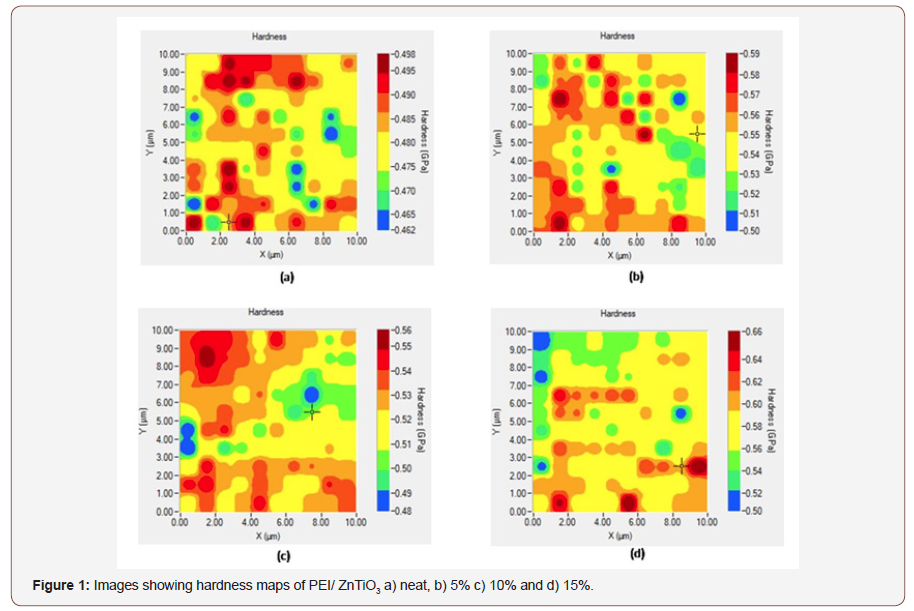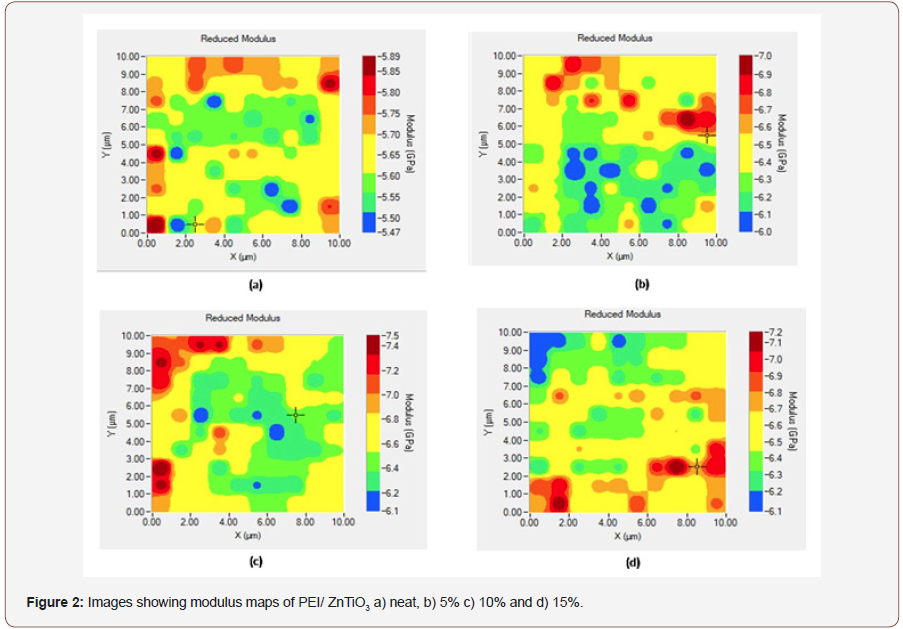 Short Communication
Short Communication
High-Speed Nanomechanical Property Mapping of Polyetherimide/Zinc Titanate Nanocomposites
Farooq Syed1, Shaik Zainuddin1*, Mohamed Elafandi1, Isaiah Wilson1, Haibin Ning2 and Shaik Jeelani1
1Department of Materials Science and Engineering, Tuskegee University, USA
2Department of Materials Science and Engineering, University of Alabama Birmingham, USA
Shaik Zainuddin, Department of Materials Science and Engineering, Tuskegee University, Tuskegee, AL, USA.
Received Date: August 01, 2019; Published Date: August 06, 2019
Abstract
Determination of mechanical properties of modern nanocomposite materials through conventional macroscale test methods is always challenging and questionable. Nanoparticles interact with polymer molecules at a micron to nanoscale, and hence to precisely determine the properties of these composites, micron level test methods such as nanoindentation need to be utilized. In this work, we have used the nanoindentation techniques combined with a recently developed novel accelerated property mapping (XPM) technique to study the statistical quantification of mechanical properties such as hardness and modulus, and the variance of these properties across the phases of polyetherimide (PEI) nanocomposites reinforced with 5, 10, 15 wt. % of zinc titanate (ZnTiO3) nanoparticles.
Keywords: Zinc titanate; Polyetherimide; Nanoindentation; XPM
Materials, Processing and Characterization
PEI is a high-performance thermoplastic polymer with excellent mechanical and tribological properties even at elevated temperature due to its high glass transition temperature [1]. In this study, PEI pellets with a melt index of 18g/10min (337°C) and density of 1.27 g/mL at 25°C purchased from Sigma-Aldrich was used. Zinc titanate (ZnTiO3) nano powder with a molecular weight of 161.26 g/mol and a <100 nm particle size (BET), 99% trace metals basis along with N, N-Dimethylacetamide also purchased from Sigma-Aldrich were used.
At first, 15gm of PEI pellets were mixed with 100ml of N, N-Dimethylacetamide (1000rpm at 150°C) for three hours until all the pellets were completely dissolved. The solution was then poured in an aluminum pan and placed on the hot plate for curing at 140°C for 72 hours. Finally, the cured samples were polished using 1.0, 0.3, 0.05 μm alumina suspensions and then mounted on to a metallic puck using a cyanoacrylate glue.
Quantitative mapping of hardness and modulus was determined by Accelerated Property Mapping (XPM) technique using Hysitron TI-980 Tribonanoindenter with a diamond Berkovich tip. XPM is a recently developed technique through which the distribution of mechanical properties along the phases of material at nano level can be determined and mapped. Also, XPM technique can perform 6 indents per second and these higher testing rates enables otherwise impractical studies requiring several thousands of indents and detailed statistical studies [2,3]. To acquire the XPM maps, a constant force of 200μN with an indent spacing of 1000nm was used over a 20x20 μm area. Several tests were carried out with 100 indents in each test for quantitative hardness and modulus maps for different wt. % of ZnTiO3.
Results
Hardness maps of PEI neat and 15 wt. % samples showed an average value of 0.48GPa (Figure 1a) and 0.58GPa (Figure 1d), respectively. A linearly increasing trend with the addition of ZnTiO3 was found. In our previous studies, we found similar enhancement at 5 wt. % loading [4]. However, optimum enhancements in these properties was observed at 15 wt.% loading with a significant increase of 20.84% and 15.96 % increase in hardness and modulus over neat counterpart (Figure 1&2).


Conclusion
Our study showed that the hardness and modulus of PEI composites enhanced significantly with the addition of ZnTiO3 nanoparticles up to 15% loading. However, we could not use beyond 15 wt. % loading of ZnTiO3 nanoparticle due to processing limitations.
Acknowledgements
The authors would like to acknowledge the National Science Foundation for funding this work through DMR-MRI # 1725513 & DMR-REU #1659506 grants.
Conflict of Interest
No conflict of interest.
References
- Kumar S, Ratha T, Mahalinga RN, Reddy CS, Das CK, et al. (2007) Study on mechanical, morphological and electrical properties of carbon nanofiber/polyetherimide composites. Materials Science and Engineering: B, 141(1-2): 61-70.
- Hintsala ED, Hangen U, Stauffer DD (2018) High-Throughput Nanoindentation for Statistical and Spatial Property Determination. JOM 70(4): 494-503.
- Li D (2015) FASTMAP: High Speed Nanoindentation Mapping.
- Yildiz K, N Karaku, N Toplan, HÖ Toplan (2007) Densification and grain growth of TiO2-doped ZnO. Materials Science-Poland 25(4).z
- Syed Farooq, Shaik Zainuddin, Isaiah Wilson, Mohamed Elafandi, Shaik Jeelani (2019) Quantitative Nanomechanical Property Mapping and in situ SPM Imaging of Polyetherimide Nanocomposites. Microscopy and Microanalysis 25(S2): 704-705.
-
Farooq Syed, Shaik Zainuddin, Mohamed Elafandi, Isaiah Wilson, Haibin Ning, Shaik Jeelani. High-Speed Nanomechanical Property Mapping of Polyetherimide/Zinc Titanate Nanocomposites. Mod Concept Material Sci. 1(5): 2019. MCMS.MS.ID.000522.
-
Zinc titanate, Polyetherimide, Nanoindentation; XPM, PEI, ZnTiO3, Materials, Hardness, Composites
-

This work is licensed under a Creative Commons Attribution-NonCommercial 4.0 International License.






